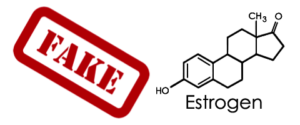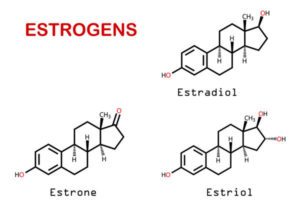
Hormonal discussions are always a hot topic. It’s no wonder why. It’s our chemical makeup. It’s what keeps us healthy and functioning properly.
But what if I told you that your body may have chemicals within it that mimic your naturally occurring hormones, with the ability to make you unwell with life-threatening diseases.
Sadly, these chemicals are lurking in many everyday items and it’s important to know where they hide.
The most destructive chemicals are undoubtedly the xenoestrogens group (basically ‘fake’ oestrogens), which I will expose today.
But, let’s cover some basics first.
You may remember from your biology lessons that females are made up of oestrogens (3 types: oestrone – E1, oestradiol – E2, & oestriol – E3), progesterone and yes, even some testosterone.
Males also contain these hormones, but obviously a lot more testosterone which sets them apart from women.
Within this trio of oestrogens, oestradiol (E2) is considered the most aggressive. When the body is in balance and free from toxins, it knows exactly what the balance between E1, E2, and E3 should be to maintain health at any age.

Oestrogen is a natural hormone in humans that is important primarily for bone growth, blood clotting, and reproduction in both women and men. The body regulates the amount oestrogen needed through intricate biochemical pathways.
The most troublesome symptoms many of my clients present with is no doubt hormonal imbalances, in particular, oestrogen dominance. This sadly affects both women and men, despite females having more naturally occurring oestrogen.
Oestrogen dominance occurs when there is excess oestrogen in comparison to progesterone. Excess oestrogen commonly occurs from constant stressful situations or trauma, but it also occurs when xenoestrogens enter the body, altering overall oestrogens levels by ‘confusing’ the body into believing they are actually oestrogens when in reality they are not.
Xenoestrogens are found in a variety of everyday items. Many of us don’t think twice about the makeup we wear each day, the plastic container we use to pack our lunch or the plastic water bottle we drink from. We also know organic food is supposed to be better for us, but sometimes we just don’t want to pay the extra money.
“We are what we eat” and “we are what we absorb” have never been truer statements based on the amount of xenoestrogen contamination that we are all subjected to.
Such ‘fake oestrogens’ can alter the way our body naturally functions because they all contain endocrine disruptors. They tend to specifically mimic estradiol (E2), creating an even more aggressive form of this kind of oestrogen than what is typically produced by the body. They push more benign and even cancer protective oestrogens aside in order to lock themselves into sites reserved for naturally-occurring hormones.

Endocrine disruptors are a category of chemicals that alter the normal function of hormones. Normally, our endocrine system releases hormones that signal different tissues telling them what to do. When chemicals from the outside get into our bodies, they have the ability to mimic our natural hormones; blocking or binding hormone receptors. This is particularly detrimental to hormone-sensitive organs like the uterus and the breast, the prostate and the testes, the immune and neurological systems, as well as human development.
Xenoestrogens are not biodegradable so they are stored in our fat cells.
Build up of xenoestrogens have been indicated in many conditions including cancers of the breast, uterine, ovary, prostate, & testicles; fibrocystic breasts; fibroid tumours; ovarian cysts; infertility; endometriosis; osteoporosis; obesity; early onset puberty; miscarriages; and even diabetes.
Below is a list of some of the sources of xenoestrogens, but it is by no means exhaustive. We are constantly exposed to these substances in the world we live in.
Some Of The Chemicals That Are Xenoestrogens
Skincare:
- 4-Methylbenzylidene camphor (4-MBC) (sunscreen lotions)
- Parabens (methylparaben, ethylparaben, propylparaben, and butylparaben commonly used as a preservative)
- Benzophenone (sunscreen lotions)
Industrial products and Plastics:
- Bisphenol A (BPA: monomer for polycarbonate plastic and epoxy resin; antioxidant in plasticizers)
- Phthalates (plasticizers)
- DEHP (plasticizer for PVC)
- Polybrominated biphenyl ethers (PBDEs) (flame retardants used in plastics, foams, building materials, electronics, furnishings, motor vehicles).
- Polychlorinated biphenyls (PCBs)
Food:
- Erythrosine / FD&C Red No. 3
- Phenosulfothiazine (a red dye)
- Butylated hydroxyanisole / BHA (food preservative)
Building supplies:
- Pentachlorophenol (general biocide and wood preservative)
- Polychlorinated biphenyls / PCBs (in electrical oils, lubricants, adhesives, paints)
Insecticides:
- Atrazine (weed killer)
- Glyphosate (weed killer – “Roundup”)
- DDT (insecticide, banned)
- Dichlorodiphenyldichloroethylene (one of the breakdown products of DDT)
- Dieldrin (insecticide)
- Endosulfan (insecticide)
- Heptachlor (insecticide)
- Lindane/hexachlorocyclohexane (insecticide, used to treat lice and scabies)
- Methoxychlor (insecticide)
- Fenthion
- Nonylphenol and derivatives (industrial surfactants; emulsifiers for emulsion polymerization; laboratory detergents; pesticides)
Other:
- Propyl gallate
- Chlorine and chlorine by-products
- Ethinylestradiol (combined oral contraceptive pill)
- Metalloestrogens (a class of inorganic xenoestrogens)
- Alkylphenol (surfactant used in cleaning detergents)
So what can you do to avoid these common chemicals?
Guidelines To Minimize Your Personal Exposure To Xenoestrogens
Food
- Avoid all pesticides, herbicides, and fungicides.
- Choose organic, locally-grown and in-season foods.
- Peel non-organic fruits and vegetables.
- Buy hormone-free meats and dairy products to avoid hormones and pesticides.
- Avoid all tinned food.
- Avoid convenient non-stick cookware (eg Teflon) & use ceramic coated pots/pans or cast iron instead (ensure cookware free of PTFE and PFOA).
Plastics
- Reduce the use of plastics whenever possible.
- Do not microwave food in plastic containers.
- Avoid the use of plastic wrap to cover food for storing or microwaving.
- Use glass or ceramics whenever possible to store food.
- Avoid styrofoam cups.
- Do not leave plastic containers, especially your drinking water, in the sun.
- If a plastic water container has heated up significantly, throw it away.
- Don’t refill plastic water bottles.
- Avoid freezing water in plastic bottles to drink later.
Household Products
- Use chemical free, biodegradable laundry and household cleaning products.
- Choose chlorine-free products and unbleached paper products (i.e. tampons, menstrual pads, toilet paper, paper towel, coffee filters).
- Use a chlorine filter on shower heads and filter drinking water.
- Avoid paints, lacquers, and solvents.
- Do not use air fresheners or artificial scents,
- Avoid car exhaust fumes in the garage and indoor toxins.
Health and Beauty Products
- Avoid creams and cosmetics that have toxic chemicals and oestrogenic ingredients such as parabens and stearalkonium chloride.
- Minimize your exposure to nail polish and nail polish removers.
- Use naturally based fragrances, such as essential oils.
- Avoid all artificial perfumes.
- Use chemical free soaps and toothpastes.
- Read the labels on condoms and diaphragm gels.
- Avoid birth control pills and spermicidals.
At the Office
- Be aware of noxious gas such as from copiers and printers, carpets, fibreboards, and at the gas pump.
As you can see, xenoestrogens are in a lot of products in many different forms. Do your best to decrease your exposure for the sake of your wellbeing and for that of your family.
**If you’ve got this far – thank you for reading and I look forward to bringing you more information in the future.
Now, enjoy some music that offers some comic relief as well …
